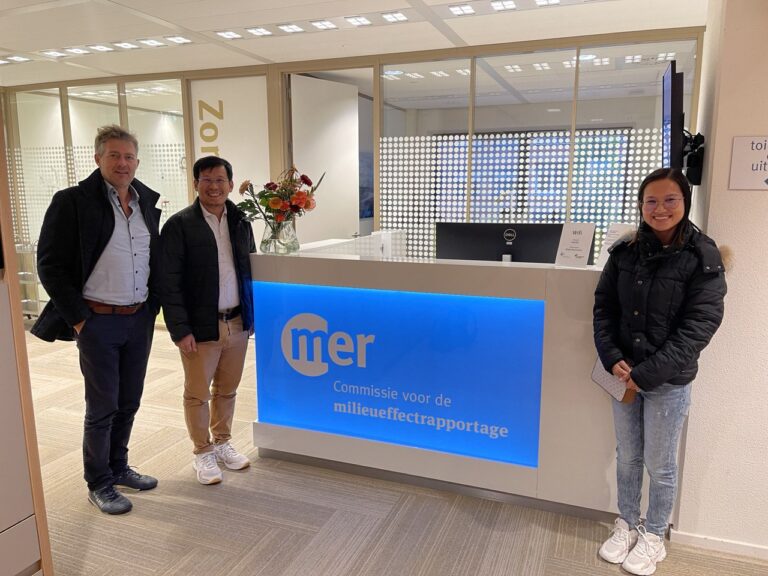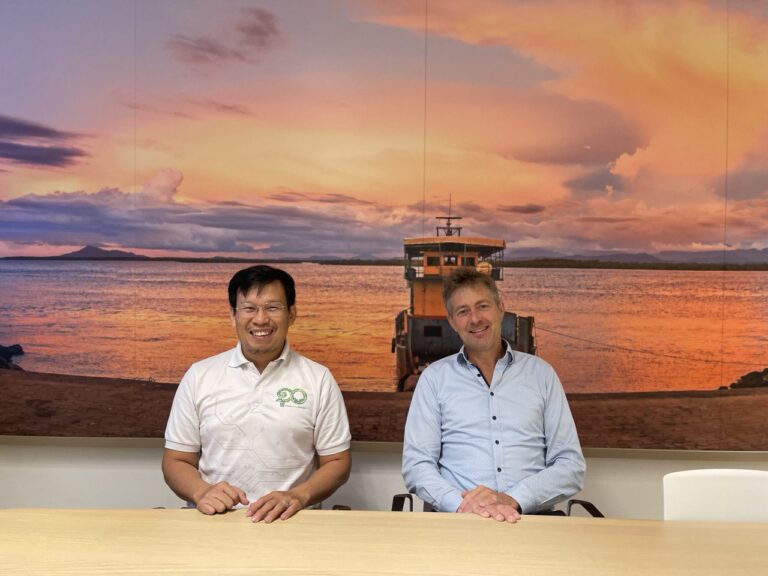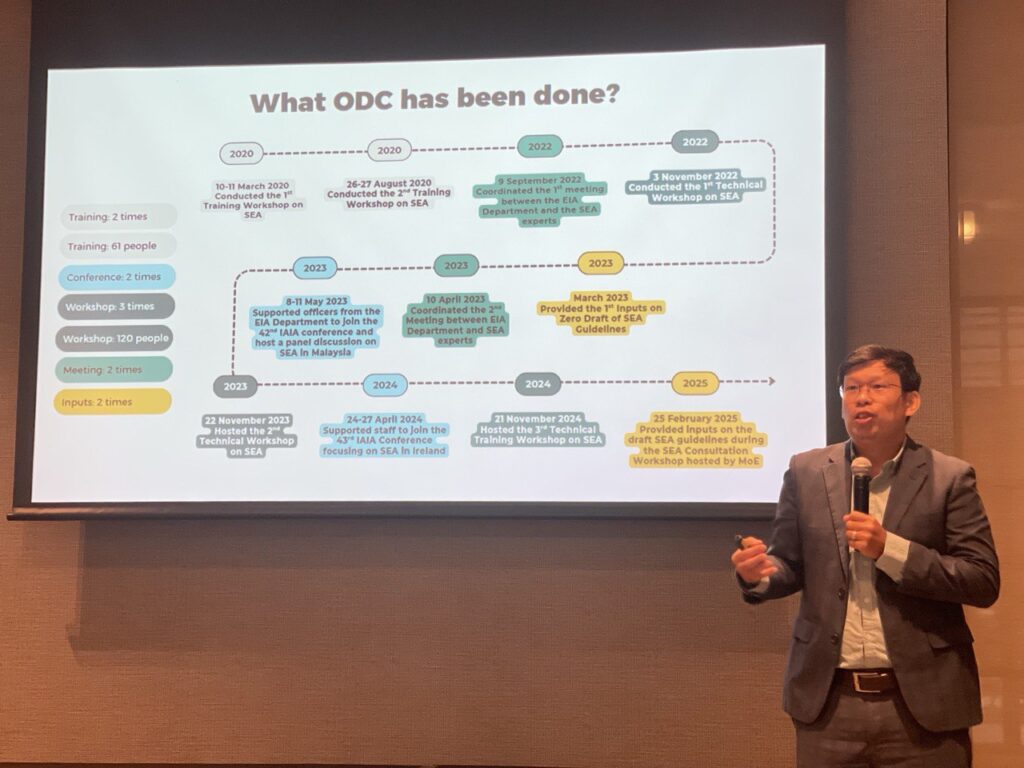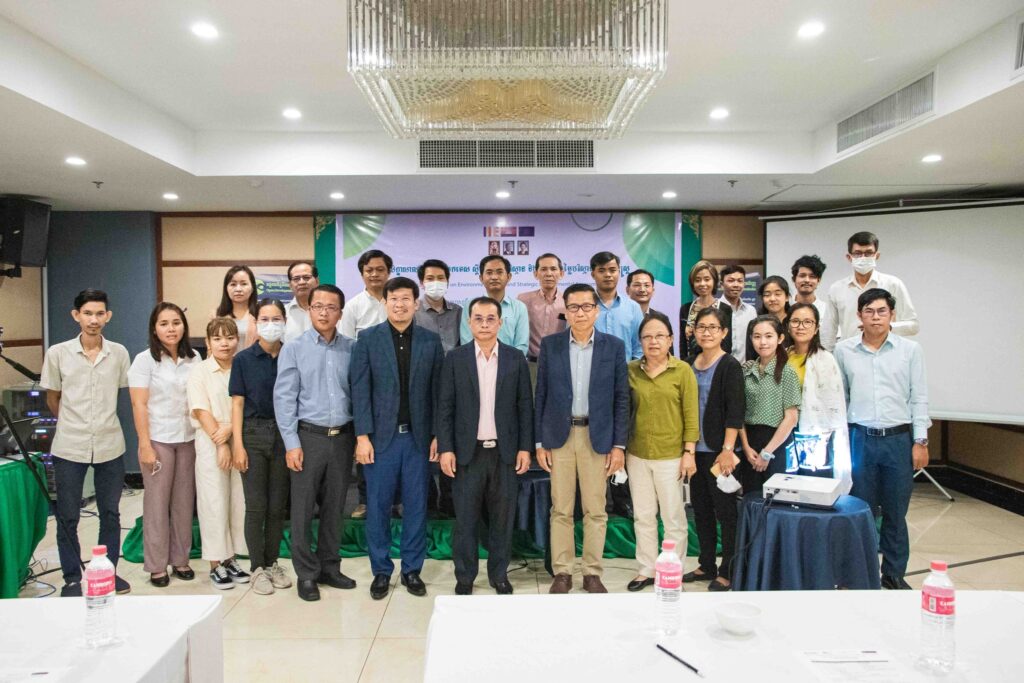- Learning Platform
- Blog
- Strategic Environmental Assessment (SEA) partner meeting with the Netherlands Commission for Environmental Assessment
On 20 October 2023, the ODC team traveled to Utrecht City, the Netherlands, to engage in a crucial meeting with Dr. Arend Kolhoff, Technical Secretary of International Cooperation at the Netherlands Commission for Environmental Assessment. ODC has been collaborating closely with the commission on providing inputs to the draft general guidelines for Strategic Environmental Assessment (SEA) and SEA for sand mining along the Mekong and Bassac Rivers in Cambodia.

The primary objective of this meeting was to critically update the progress and challenges that have emerged within the area of SEA in recent times. The discussion focused on the ongoing work regarding SEA within the Cambodian context.

The National Council for Sustainable Development (NCSD) of the Ministry of Environment of the Kingdom of Cambodia established the National Training Team on Strategic Environmental Assessment (NTTSEA) on 20 December 2022. The team is responsible for arranging and preparing training materials, disseminating SEA knowledge at national and sub-national levels, and raising awareness through a range of meetings, training sessions, and workshops. In addition to their educational activities, NTTSEA has mobilized resources and forged partnerships with NGOs and other stakeholders, in a determined effort to foster a comprehensive training program on SEA.
Stay tuned for more updates on this journey towards sustainable development!
Other Stories
National summit on influences of forestry and land regulations on local communities and comprehensive EIA process
Open Development Cambodia (ODC) organized a national summit on “Influences of Forestry and Land Regulations on Local Communities and Comprehensive EIA Process” on 25 May 2023 with a total of 43 (13 females) representatives from the Ministry of Rural Development (MRD), CSOs, EIA firm, journalists, and indigenous peoples from Ratanakiri, Mondulkiri, Kratie, Pursat, Stung Treng, Preah Vihear, and Kampong Thom provinces. The event was supported by the United States Agency for International Development (USAID) through Family Health International (FHI 360) under the Civil Society Support Activity: Cluster Anchor Grants, and Heinrich Böll Stiftung Cambodia (HBS) under the project of promoting EIA for more transparent and responsive environmental governance in Cambodia. The national summit aims to: Provide an opportunity for relevant stakeholders to express their concerns regarding existing and proposed forestry and land law and associated regulations Identify the effective strategy to provide input into the draft laws Discuss how the proposed law and associated regulations will interact with the EIA process, particularly the engagement of local communities and the public more broadly. The team invited Mr. IL Oeur, Executive Director of Analyzing Development Issues Centre (ADIC), and Ms. YA Yanny, a representative of indigenous women from Mondulkiri province to be the speakers. Mr. THY Try, Executive Director of ODC was the moderator of the panel discussion on “Forestry and land regulations”. The discussion started by introducing the speakers as well as their work. Analyzing Development Issues Centre (ADIC) shared their research on public participation in Prey Preah Roka Wildlife Sanctuary and Chhaeb district, Preah Vihear province. The Ministry of Environment (MoE) had clear guidelines and engaged the local community in the process. They set up numerous local and national meetings for two years to map the areas. This is the first map that engages many people, so there are no concerns raised by the local community during the mapping process. The concern is that when the map is released, who will be responsible for border demarcation? The land inventory is also significant to identify the specific land that each indigenous people own within the communal land title. Then questions were raised around the differences in duration of the indigenous communal land titling and private land title as well as the word usage in the law. A representative from the Cambodia Indigenous Peoples Organization (CIPO) shared the concern on the indigenous community cannot do the rotation or traditional agriculture unless they have been registered. That’s a critical point if the community grows the crop or rice on the land. A response from the MRD, if the community has been recognized as an indigenous group by the ministry, there should not be a problem to use the land. The representative from CIPO also mentioned the concern about excluding the word “Indigenous peoples” in the draft law. Indigenous peoples would like to keep their identity (differentiate from other people) both in the current and upcoming laws. Regarding the input, we would like to see a separate chapter talking about the indigenous people within the Land Law. The discussion between the CSOs and indigenous peoples should be happened before meeting with the related ministries to share their concerns to address in the draft law. The discussion around the reasons for revising or amending the law should be widely disseminated. The government should open for consultation with practical and concerned stakeholders. A representative from 3SPN stated that the draft EIA law excludes the word “FPIC” meaning free, prior, and informed consent. The law encourages to have full public participation in all areas. Fully participation has a different definition from FPIC which considered accessing the information, participation, and decision-making. The participants highlighted that cooperation and working together among key CSOs is very important. By doing so, we could enforce and coordinate the mechanism and inputs effectively. There is an interesting question from the private company regarding indigenous peoples’ economic, livelihood, and materials trends. The question has attacked the attention of indigenous peoples in the rooms to share where they are now. They said, \"Some people get a larger house and modern materials, but some of them have to pay back the loan every month. Some people are poor and do not even have a small area of land to grow crops. What we are now cannot be compared with what we have lost. Although we need to adapt to the modern era, we would not want to lose what we used to have, especially the culture.\" In brief, we discussed the inputs which also reflect several significant points including cooperation among key stakeholders and CSOs in the input gathering and providing to the policy-makers as well as networking with the related ministries, case studies in Mondulkiri, Ratanakiri, and Preah Vihear, and the word usage in the law. The panel discussion on “EIA process: Public participation” brought together Mr. HORM Kimkong, Director of Environmental and Assessment (E&A) Consultancy, Mrs. TEP Tim, a representative of indigenous women from Preah Vihear province, Mr. LEANG Bunleap, Executive Director of 3S Rivers Protection Network (3SPN). The discussion was moderated by Mr. LONN Pichdara, Executive Director of MyVillage Cambodia. Mrs. TEP Tim living in Prame commune, Tbaeng Mean Chey district, Preah Vihear province, said that she did not get an invitation to join the public participation of the EIA process as well informed about the development project beforehand. So far, they only invited the commune and district councils to the meeting. A representative from 3SPN stated that public participation sometimes could provide the opportunity for the company to only gather the people who agree and support the project. The law or regulation on public participation is very important, and it should clearly state who should be invited to join such as from the beginning of the process. “When we are discussing the Land Law, it should also refer to the Cambodian people as well. Why the discussion this morning was focusing on indigenous peoples only?” Question from our participant. Yes, it should be referring to everyone. However, we would like to pay more attention to the indigenous peoples because they are the most vulnerable group among others. From time to time, they live and survive in the forest and do not have any land titles as we do. When there is a development project, they always eye on the forest areas where there are not many people living there. In the case of Cambodia, some projects just process the EIA after a long-term operation. The participants wonder what is the point behind that. EIA is just a tool to assess the impact, not a law. There are three types of EIA implementation including EIA before, during, and after the project implementations. The companies that were established a long time ago do not have EIA since it did not exist at that time. As a result, the MoE review and request them to do the EIA. The new development projects currently must have done the EIA before implementing the project based on the guideline of the ministry. EIA report is very difficult to get. How could we get the EIA reports? Normally, when the report is approved, the consultant, project owner, and the MoE have to stamp each page of the report. Previously, the consultant has to prepare 12 copies, but currently, there are only six copies required which will be kept by the consultant (1), the project owner (1), and the rest will be kept by the EIA Department. The consultant needs to keep the report in a safe place for 3 or 5 years based on the agreement, and they cannot share the report without permission from the project owner. The report could be officially requested from the MoE. Our speakers also suggested the community and CSOs keep all the related documents they provided during public participation. The discussion and content of the provided documents will not have much difference from the approved EIA report. Additionally, the stakeholders should focus on the EIA training for the local community so that they could understand the process as well as the content of the report.
Inception workshop on Strategic Environmental Assessment (SEA) phase II: ODC shares experiences on SEA
On 17 June 2025, Open Development Cambodia (ODC) participated and served as speakers at the Inception Workshop on Phase II of Strengthening the Strategic Environmental Assessment (SEA) Process through Capacity Development, a collaboration between the Ministry of Environment (MoE) and The Asia Foundation (TAF). The workshop was attended by approximately 40 participants from the Ministry of Environment (MoE), Ministry of Mines and Energy (MME), Ministry of Tourism (MoT), Ministry of Agriculture, Forestry and Fisheries (MAFF), Council for the Development of Cambodia (CDC), Ministry of Economy and Finance (MEF), Ministry of Public Works and Transport (MPWT), Ministry of Land Management, Urban Planning and Construction (MLMUPC), Ministry of Planning (MoP), Cambodia National Mekong River Committee (CNMC), Ministry of Water Resources and Meteorology (MoWRAM), Ministry of Posts and Telecommunications (MPTC), Global Green Growth Institute (GGGI), United Nations Development Programme (UNDP), World Wildlife Fund for Nature (WWF), and the Embassy of Australia. The workshop aims to (1) identify opportunities and challenges in implementing SEA in Cambodia, (2) brainstorm ideas related to the preparation of a sub-decree on SEA as stipulated in the 2023 Environment and Natural Resources (ENR) Code to support the implementation of SEA, and (3) expand capacity-building opportunities on SEA for national and sub-national officials. In 2025, MoE and TAF re-engaged to continue the SEA initiatives, beginning with a senior management meeting to discuss key issues and further advance the implementation of SEA in Cambodia. A priority task is to develop and promote the integration of SEA into policies, strategic plans, and action programs across relevant sectors. This effort aims to achieve sustainable development and support the implementation of the Pentagonal Strategy Phase I of the Royal Government of Cambodia of the Seventh Legislature of the National Assembly. SEA plays an important role in integrating environmental issues into the formulation of policies, strategic plans, and action programs in key sectors outlined in the code. H.E. Dr. Chuop Paris, Secretary of State of the MoE, presided over the opening of the workshop. On that occasion, H.E. emphasized that the implementation of the activities for the second phase is to strengthen broader cooperation on the preparation of documents for SEA covering the seven priority sectors as defined in the Nationally Determined Contributions 3.0 (NDC 3.0) document to ensure sustainable development, focusing on the three pillars: economy, society, and environment. The preparation of SEA is very important for relevant ministries and competent institutions to put forward their sectoral strategic plans to jointly achieve sustainable development and ensure a good environment that takes into account cleanliness. H.E. also emphasized that the workshop should consider preparing legal documents on SEA as stipulated in the ENR Code, such as sub-decrees or guidelines on SEA in each sector. It is also worth noting that the collaboration for Phase 1 has achieved positive results, including the completion of a study on the scope of SEA in Cambodia, capacity building for civil servants, and training of trainers in SEA. The workshop presented the current status of SEA in Cambodia, including the background of SEA in Cambodia, the latest developments, and the plans for 2025-2027. Currently, MoE is preparing the General Guidelines on SEA in Cambodia and the Guidelines on SEA for the Sand Mining Business in Cambodia. In 2025-2027, MoE will prepare a sub-decree on the SEA procedure, the SEA framework analysis, and the training of trainers (ToT). Mr. Thy Try, Executive Director and Editor-in-Chief of Open Development Cambodia (ODC), presented an overview of SEA as well as previous SEA reports. At the same time, he also presented the work that ODC has done about SEA in Cambodia, such as training, workshops, consultation meetings, conferences, and providing input to the SEA Guidelines. ODC has been working on SEA since 2020 until now. ODC collaborated with MoE and the Non-Timber Forest Products Exchange Programme (NTFP-EP Cambodia), supported by the Netherlands Committee for IUCN, to organize two training courses with approximately 61 participants from relevant departments and civil society. ODC also participated in two overseas conferences and discussions on SEA in the Mekong countries. To promote broader understanding, ODC organized three workshops with a total of 120 participants from relevant ministries, civil society, journalists, and indigenous communities, supported by Heinrich Böll Stiftung (HBS) Cambodia and FHI360-CSS. ODC coordinated with foreign experts to provide input to the draft General Guidelines on SEA in Cambodia and the Guidelines on SEA for the Sand Mining Business in Cambodia. It should be noted that ODC is also committed to collaborating and actively participating in activities related to SEA in Cambodia.
- Environmental impact assessment (EIA)Land and natural resources
- 20 Jun 2025
- 875
Environmental data and strategic environmental assessment (SEA)
Phnom Penh, 03rd November 2022, Open Development Cambodia (ODC) hosted a Technical Workshop on Environmental Data and Strategic Environmental Assessment (SEA). This workshop was supported by the United States Agency for International Development (USAID) through Family Health International (FHI 360) under Cluster Anchor Grant from the Civil Society Support (CSS) Project and Heinrich Böll Stiftung (HBS) under Promoting Environmental Impact Assessment (EIA) for a more Transparent and Responsive Environmental Governance in Cambodia Project. The workshop aims to: Raise awareness of the SEA among CSOs, citizen journalists, indigenous people, and researchers. Discuss and share the current statue of the SEA in Cambodia Identify the potential of integrating SEA and its implication in environmental and natural resource management. The event brought together 32 participants (11 females) from the Ministry of Planning (MoP), World Wide Fund for Nature (WWF), Wildlife Conservation Society (WCS), Family Health International (FHI 360), other international and local non-governmental organizations (NGOs), community-based organizations (CBOs), journalists, researchers, and indigenous peoples (IPs). Environmental Impact Assessment (EIA) and Strategic Environmental Assessment (SEA) Mr. THY Try, Executive Director/Editor-in-Chief of Open Development Cambodia, and Mr. MATHEW Baird, Director of the Asian Research Institute for Environmental Law, have highlighted the differences between EIA and SEA as well as some procedures of SEA. Development projects typically promote economic development, but they should not neglect or ignore the impact on the environment and society. SEA incorporates environmental considerations into policies, plans, and programs (PPP). SEA is used to estimate and evaluate the consequences of specific development PPP. It means that the project is not there yet. The government will decide whether the project could be implemented or invested in that area. It usually happens before doing the EIA. In contrast to the commonly used EIA, which occurs after the decision-making process, SEA occurs before all important decisions, which offers significant advantages. It was initially promoted to fill gaps in project-based EIA due to the limitation of EIA to address the environmental policy integration at the strategic levels, particularly during policy and plan-making. The capacity of EIA to account for the strategic consequences of subsequent projects in a single area is limited. As a multi-stage process focusing on overall sustainability, SEA takes a proactive approach to all development activities, identifying key obstacles before final approval. Public participation is the key point, and it must be included in both SEA and EIA processes. EIA and SEA complement each other. It does not mean that we can ignore one of them. Mr. THY Try also demonstrated a video about the UNECE SEA Protocol, which was created by the United Nations Economic Commission for Europe (UNECE) as part of the EU-funded program “Greening the Economies in the European Neighborhood.” The protocol establishes clear and transparent procedures for incorporating environmental and health concerns into national development plans, programs, and legislation. Spatial Plan and its Integrated Landscape Approach Mr. SENG Teak, Country Director of the World Wide Fund for Nature (WWF), presented one of the significant implementations called the “Mondulkiri Provincial Spatial Plan.” He highlighted the 2040 scenario-based analysis for the province divided into three scenarios: conservation, green economy, and business-as-usual. The first scenario, “conservation,” could keep the forest cover in Mondulkiri up to 85% by mainly protecting all forests inside and outside the protected areas (PA) and using non-forest areas for agricultural and development areas. The second scenario, “green economy,” only protects the forest in the PA, whereas the forest outside the PA and non-forest areas are used for agricultural development areas. By doing so, the forest cover in the provide will remind 53% by 2040. In the last scenario, “business-as-usual” will not enforce forest protection, and the forest cover will remain at only 34%. In brief, the second scenario is used for the spatial plan for Mondulkiri and will be adopted shortly. The spatial plan is critical because it has the potential to provide effective development principles and tools for informed decision-making and spatial development processes to promote balanced territorial development. The planning could be done by following significant steps, including establishing a multi-stakeholder platform, building a shared understanding, collaborative planning, implementing, monitoring for adaptive management and accountability, and shaping the context. The potential of SEA Integration and its Implication on Natural Resource Management H.E. NOR Vanndy, Director of the Economic Statistics Department, National Institute of Statistics, Ministry of Planning (MoP), and Mr. TEP Sakmakara, Deputy Chief of Office of the Department of Economic Statistics, MoP, highlighted how the ministry addresses the environmental data and issues in the development plan. Integration of environmental issues in the development plan is the initial stage, and the country should do it. Environmental issues are considered to include in long-term and medium-term development plans such as National Strategic Development Plan (NSDP) and Sector Development Plan. It was observed that the integration of the environmental issues in the previous NSDP (2014-2018) is less and not paid much attention. Therefore, the government has considered and added more environmental issues to the new NSDP (2019-2023). Chapter 4 (4.42) of the NSDP (2019-2023) “Promote the inclusion of strategic environmental assessments in the decision-making process, policies, plans, and legal documents to ensure the sustainability of the environment and natural resources.”
- Environmental impact assessment (EIA)Land and natural resources
- 08 Dec 2022
- 3209


